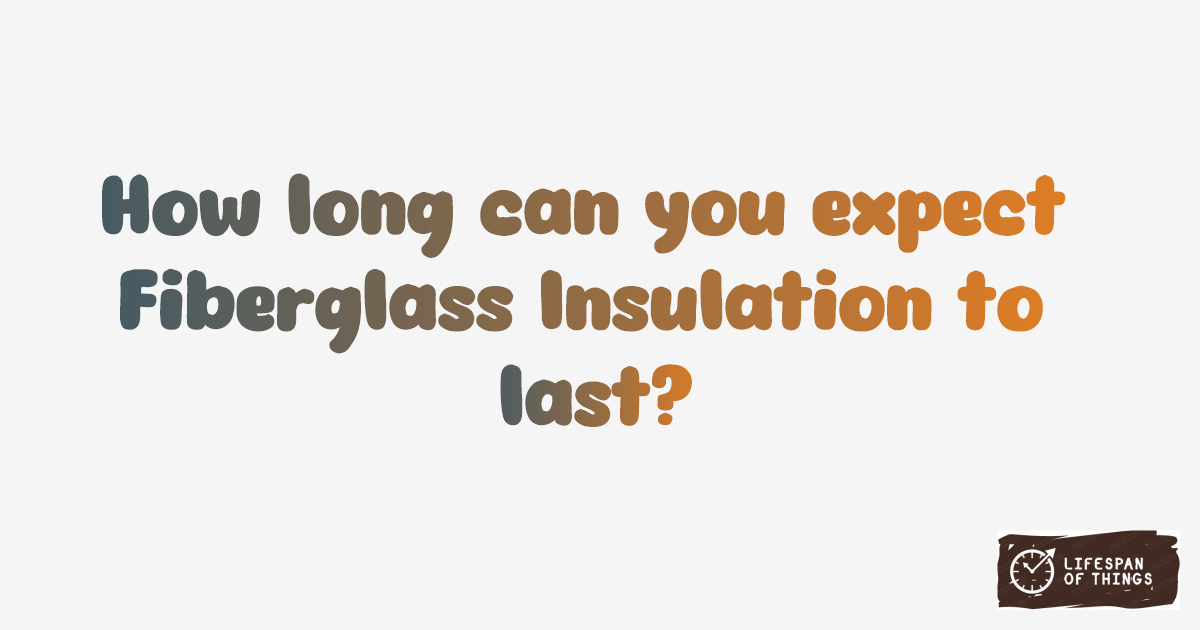
20 - 50 Years
Lifespan of Fiberglass Insulation is 20 - 50 Years. Fiberglass Insulation's lifespan can be influenced by factors like installation quality, moisture exposure, and temperature fluctuations. Proper installation techniques, regular maintenance, and addressing any leaks or damage promptly can help extend its lifespan.
Useful Information
Fiberglass Insulation is known for its thermal insulation properties and fire resistance. It is composed of fine glass fibers bonded together to create a strong and flexible material. Types of Fiberglass Insulation include batts, rolls, and blown-in insulation, each designed for specific applications.
Fiberglass Insulation is commonly used in residential and commercial buildings to regulate indoor temperatures and reduce energy costs. It is also utilized in automotive and marine industries for soundproofing and thermal insulation. Innovative applications include using Fiberglass Insulation in green construction projects to enhance energy efficiency.
The durability of Fiberglass Insulation varies based on exposure to moisture, chemicals, and extreme temperatures. Properly installed and maintained Fiberglass Insulation can last 20-50 years. Factors impacting its lifespan include humidity levels, ventilation, and insulation thickness. Regular inspections and addressing any issues promptly can help prolong its durability.
The durability of Glass Fiber varies with factors like temperature, moisture, and pressure, which can affect its lifespan. Learn how maintenance and coatings can extend its longevity. Read more
The production of Fiberglass Insulation involves energy-intensive processes, but it is a recyclable material that reduces waste in landfills. Proper disposal methods and recycling efforts can mitigate its environmental impact. Look for eco-friendly Fiberglass Insulation alternatives or sustainable practices to minimize environmental harm.
To care for Fiberglass Insulation, keep it dry and free from water leaks to prevent mold growth. Regularly inspect for any signs of damage and repair them promptly. Avoid compressing or covering insulation with materials that can restrict airflow. In case of maintenance, consult a professional to ensure proper handling and installation.
Lifespan Comparisons
| Compared Item | Comparison Description |
|---|---|
| Lifespan of Polypropylene (PP) | Fiberglass insulation lasts significantly longer than Polypropylene (PP) material, offering a lifespan that is double or even triple in duration. |
| Lifespan of Polyvinyl Chloride (PVC) | Compared to Polyvinyl Chloride (PVC), fiberglass insulation has a lifespan that is relatively similar, providing adequate durability for the long term. |
| Lifespan of Polystyrene (PS) | While Polystyrene (PS) and Polyethylene Terephthalate (PET) offer incredibly long lifespans, fiberglass insulation provides a balanced duration suitable for various applications. |
| Lifespan of Polyethylene Terephthalate (PET) | Fiberglass insulation offers a more moderate lifespan compared to Polystyrene (PS) and Polyethylene Terephthalate (PET) materials, striking a balance between longevity and practicality. |
| Lifespan of Fiberglass Panels | Fiberglass insulation has a similar lifespan to fiberglass panels and sheets, ensuring consistent durability and longevity for insulation needs. |
| Lifespan of Fiberglass Sheets | With a comparable lifespan to fiberglass panels, fiberglass insulation provides reliable protection and insulation over an extended period. |
| Lifespan of Fiberglass Mesh | In terms of durability, fiberglass insulation outlasts fiberglass mesh with a longer lifespan, providing lasting insulation for various settings. |
| Lifespan of Fiberglass Cloth | Compared to fiberglass cloth, fiberglass insulation offers a more extended lifespan, ensuring reliable and efficient insulation over the years. |
| Lifespan of Puma Fuse | Fiberglass insulation surpasses Puma Fuse in terms of longevity, ensuring insulation needs are met for an extended period. |
| Lifespan of New Balance Minimus TR | New Balance Minimus TR falls short in lifespan when compared to fiberglass insulation, highlighting the insulation's durability and longevity. |
| Lifespan of Spalding NBA Official Ball | For long-lasting insulation solutions, fiberglass insulation outperforms the Spalding NBA Official Ball with a significantly longer lifespan. |
| Lifespan of Wilson Evolution Basketball | Wilson Evolution Basketball offers durable performance but has a shorter lifespan compared to fiberglass insulation, making it a reliable choice for insulation needs. |
| Lifespan of Molten GG7X Basketball | Molten GG7X Basketball provides quality play but falls short in lifespan when compared to fiberglass insulation, ensuring lasting insulation solutions. |
| Lifespan of Nike Elite Championship Ball | Nike Elite Championship Ball has a shorter lifespan compared to fiberglass insulation, highlighting the latter's longevity and durability in insulation applications. |
| Lifespan of Baden Elite Basketball | When seeking long-term insulation solutions, Baden Elite Basketball does not compare to the extended lifespan offered by fiberglass insulation. |
Frequently Asked Questions
Lifespan of Fiberglass Insulation is 20 - 50 Years.
Factors like moisture exposure, temperature fluctuations, and improper installation techniques can affect the durability of Fiberglass Insulation.
Regular maintenance, addressing leaks promptly, and ensuring proper installation can help extend the lifespan of Fiberglass Insulation.
Batts, rolls, and blown-in insulation are common types of Fiberglass Insulation, each serving specific applications based on their design.
Fiberglass Insulation is recyclable, reducing waste in landfills, and can enhance energy efficiency in green construction projects.








